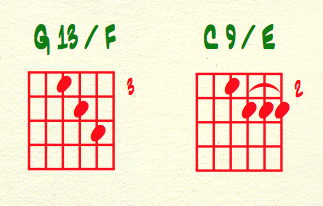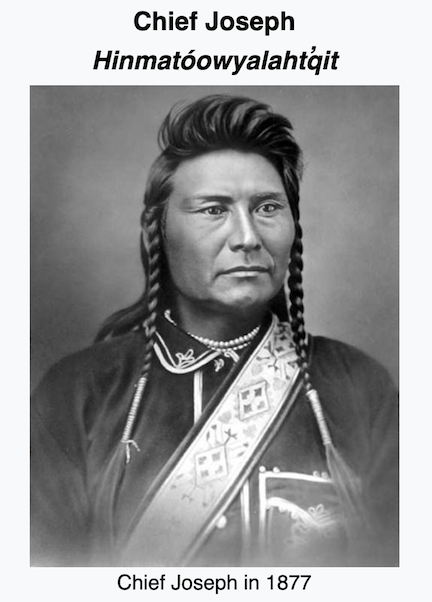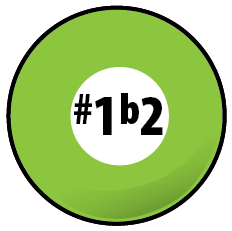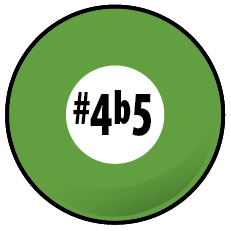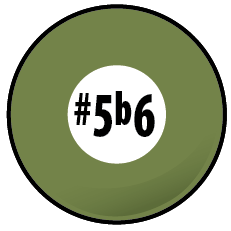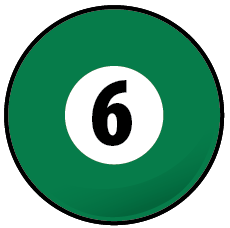~ 13 ~ Thirteen ~ 'up an octave, our diatonic 6th is now a 13th, and a potent spice in the diatonic pie ...'
|
In a nutshell. Our Thirteen is simply Six up a full octave. That Six is home to the diatonic relative minor group of pitches should help illuminate its potential importance as Thirteen. Thirteen is almost always thought of as a chord tone, so a pitch in an arpeggio or chord. A color tone that sits atop various combinations of 7, 9, and 11, and mostly with the major or minor triads. Remember that by including a 7th to a triad, we get chord type, and thus a new, 'up an octave' level of theory potentials of the lower numbers. Please examine the letter name pitches in C major to locate the 13th. Root 'C' up an octave then adding a major 6th interval = 13'. Example 1. |
|
Wide space between 1 and 13. These 13th chords are pretty colossal in interval distance. As the chart shows, we're closing in on our second octave closure. Thus the following root position voicings for guitar are built from the lowest 'E' and 'A' strings. |
So why a summit? Well in nearly all of our American sounds and styles, our chordal colortones reach their highest popular point or summit numerically at 13. We'll look at 14, 15 and even a new idea for #15, but these types of numerical designations are entirely absent in our written Americana music, we just never see them. So we in a sense top off the arpeggio at 13. So what can be seen from this summit? |
The essential balance. As the Six / Thirteen pitch is also home to our relative minor position within our diatonic scale, an interesting color transformation occurs when we add this hue to our chord voicings. It just seems that whenever we 13 add into a chordal mix, the music takes on a heightened sense; whether it's a stronger pull of the swing, or the heartfelt longing of the minor 9/13 chords, or just a bit brighter as in the jump blues '6' chords, finding a chord with just a bit more 'joyous' for the last hold of an arrangement. |
At the summit. An example of this idea of a summit point between our Yin / Yang dichotomy, hear and sense how easily our V13 chord, here as G13, slips towards both the relative tonic chords of A minor and C major. Example 2, holding the 13th as a common tone through the chords. |
 |
Soften the tonic colors. By softening the tonic triad colors in this last idea even a wee bit, to a different shade or hue of tonic stability, we discover that at this upper, summit 13th level of our dominant arpeggio, our ability to subtly project our art towards either a major or minor key center can be easily realized. Example 3. |
 |
Smooth moves ? Cool yea, jazz leaning opens things up. |
Transitions between our major and minor tonal centers. In surveying through styles and songs in our Americana songbook, we see that how we choose to weave our composition's story line through our major and minor colors is an exciting part of the compositional craft. For in all of our styles, we can find this shifting between major and minor, and vice versa of course. Are we aurally portraying the two sides to each story? The call and response of human endeavor? The sense of hope of knowing that it's always darkest before the dawn? |
So where is 13 in the music? In children's songs and folk music we'll surely see our Six colortone way more that Thirteen. But once we add a bit of the blue 7th / dominant spice, Thirteen becomes and essential color for many cats. So as the blues is simply core roots of Americana, any style with a bit of the blues influence and we'll probably be able to also find the 13th color. |
Similarly, 13 is a very common jazz color, so any style with a jazz influence would probably welcome this chordal coloring i.e., pop and various fusion musics. As we go through the following voicings for 13th chords, we'll examine the musical styles too. |
Theory properties / names. Turns out all three of our chord types unreservedly support the 13th. That the pitch is absolute organic and diatonic, and is also the relative minor position in the major diatonic scale, surely wins 13 the day. We label them as 13th chords mostly, meaning we've some sort of 7th below in our chord and the 6th is simply transposed up an octave to the 13th position above in our arpeggios and chord voicings. |
Tonic chord shapes / 13th. Please examine the tonic functioning / 13 chord shapes in C major. Example 4. |
 |
Two chord / ii - minor shapes / 13th. Thinking along the lines of the Two chord / 13th chord shapes in C major, thus the D minor basis. Example 5. |
 |
Two nice chunks huh ? The first one, the 'D' minor 9 / 13 is a super modal potent ... a please bring that mode now invoking chord shape. Super movable up and down, it too rolls through the musical styles just as wide. And modally? It's at a kingly level. |
Dominant / V 13 chord shapes. Thinking Five chord / 13 chord shapes in C major thus the D minor basis. Example 6. |
 |
Know these shapes? Two true keepers for the blues leaning, funk filled dancefloor leaning super jazz bring the swing or walk a bass line too chords. If they're new shapes for you, honored here to hip ya to these 13th colortone, V7 chords. In the bonus. Too good to be true ya know, but both these big rooters' also slim down too, simply by leaving off the root pitch. Create for yourself a couple of choruses of 12 bar blues using just one shape. Then combine them together into some choruses for double the fun. And ... believe me when I tell you ... there's a ton here :) Here's the two shapes, the first of which might just be a bit sleeker / faster ... you decide :) Motion to Four, these are 'incomplete dominant 7th chords, in 3rd and 1st inversion respectively.
Ooops on the 'C 9 / E', needs an 'A' in the lead, 5th fret.
|
Quick review ~ good mileage. These last eight root position shapes, plus two inversions, should give you pretty good mileage over the course. These next two chords are 'inversions', voiced with the 7th of the chord as our lowest pitch, we create a third inversion / V 13 chord. Not quite so 'incomplete' this time as the root pitch is in the chord, top voice. Thee two are the same exact voicing, just two different shapes created from two different 'set' of four strings. Rockabilly and jump cats love these two colors, hands down essential. Ex. 7. |
|
 |
That's trippy. Two different shapes exact same sound :) |
Thirteen in action. Let's place the above shapes in spots we'd commonly find them in the music. Thinking musical style / context, the following ideas emerge. |
Children's songs and Folk music. Probably 'hens teeth' to find these bigger shapes in these styles. The Six colortone is common of course, especially with songs in C major, as the open chord shape is accessible. Here is a Four / Five / One folk cadence ending up on C6. Example 8. |
 |
The blues. Blues chords of course need a blue / dominant 7th to start to capture the magic. When we combine this with 13, we gain a solid functioning blues tonic structure chord that supports a number of different approaches of blue melodies, i.e., blues rock, country blues, jazz etc. This next bluesy V 13 voicing is very common. Here we use it as a constant structure to cover the principle One / Four / Five / One chords of our blues. Example 9 with a boo boo chord symbol :( sorry. |
Thumb pickers. Those of us that play fingerstyle get a wide open thumb shot at the bass note of this chord shape. So if you like to get a bass line going with your chords, this'll be a good chord to know. |
Funk. Funk is a combination of rock and blues with a big wide 2 and 4 dance groove. Our 13th colortone plays a huge role as a sort of add on to our funky dominant 9th chord, which motors the bulk of the funk music of the 70's and onward. So we sound the the basic V9 chord then 'funk it up' with the added 13. Treble up your Strat and find a light pick :) "And dig that half step lead in ... " Example 10. |
 |
Bossa Nova. In this next idea we use a tonic function 13th chord to set up the core bossa guitar pulse. And while our 13th is built into the chord, we have the option of alternating our bass with a root / Five motion, so common to the bossa / Latin grooves adored by the dancers. Example 11. |
|
 |
BeBop. In a bop direction ... and as the general nature of bop is faster tempos, our chords oftentimes need to slim down a bit to gain the necessary sleekness for making the changes. One secret in sounding this sleekness lives in our picking / strumming hand. One approach with jazz guitar is the patented four finger / four string / four pitch school of modern guitar. This 'four and four' combo is also 'three and three, or two and two, even one and one', as our music moves from chords toward single note melody lines. |
|
As the Two / Five / One motion is the core cadential of bebop, here are two 'lighter' turnarounds created with movable V13 chord voicings. The idea of light here implies that we use chord inversions, and thinking we'll let the bass player do the heavy lifting of harmony root motion bass story line testimony. Example 12. |
 |
Sleeker yes? And a bit of quartile stacking to boot! |
Straight Ahead. In what players term 'straight ahead' jazz, our voicings are oftentimes a combination of root position chords and their inversions, though either way and like blues chords, all have their 7th's and varied colortones. This next idea simply adds roots to the chords from our previous example. So the 'mix and match' process of these groups, with really any other chords, is in full force. Example 13. |
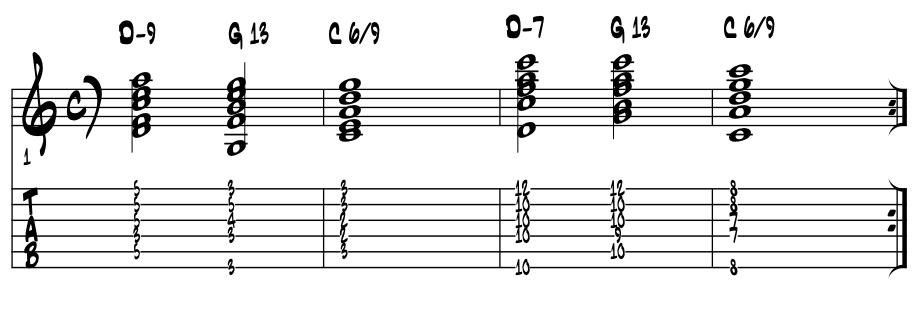 |
Cool? A / B these last two examples back and forth to find the root pitches in the mix. Sing along if so inclined. |
Minor modal fusion and beyond. We can find and use this next ii 9 / 13 chord voicing in many spots in jazz music, a bit in blues and pop too. It's a rather strong and sturdy chord and color, invoking a rather deep sense of minor, its longing and depth of heartfelt compassion. For emerging jazzers, performing compositions such as Trane's "Impressions", this minor 13th voicing would be a potential first choice to learn and enjoy. Example 14. |
|
 |
Minor 13th chords / Dorian mode. Even from just the wee bit of music in this last idea, we gain a glimpse of the power of this minor 13 voicing and its strength in characterizing and capturing the emotional qualities of our Dorian mode. The Dorian grouping historically goes way back in our written records and was at the core of the modal jazz of the 1960's. |
|
Review and beyond. The colortone we call Thirteen is at its core theory just a major Six plus an octave up from our root pitch. While mostly a jazz color, the 13th finds its way into the blues and pop music. Loved by the rockabilly crowd, the V7 / 13 is the jump chord of choice in this local universe. Broad yet somewhat restive due to its perch atop our diatonic arpeggio, Thirteen sits and is the transition point between our major and minor tonal environments. As a minor tonic color, adding the Thirteen atop a 7th or a 9th colortone, brings forth the depth of our Dorian mode, that ancient grouping and color that lives in our DNA. |
|
"It does not require many words to speak the truth." |
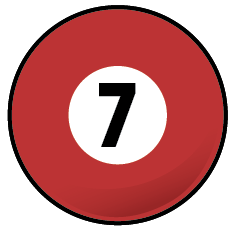 |
 |
|||||||||||
 |
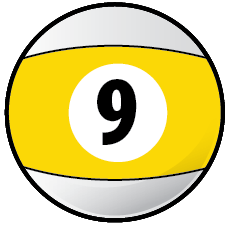 |
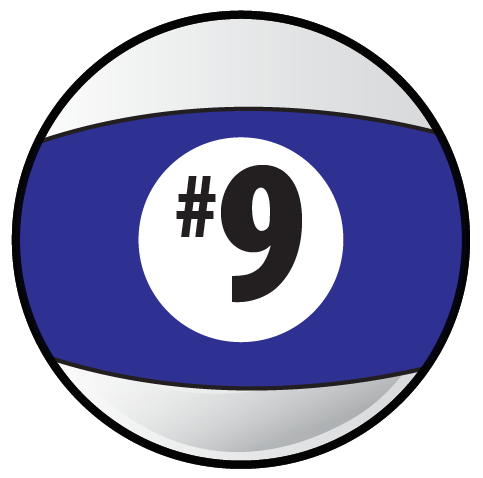 |
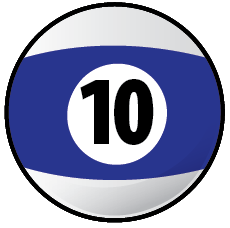 |
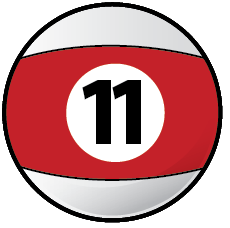 |
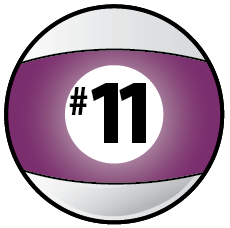 |
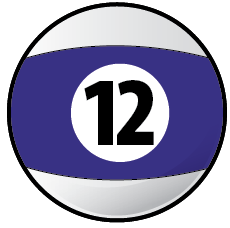 |
 |
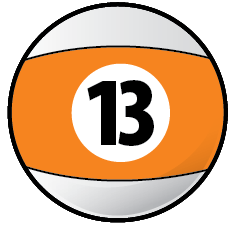 |
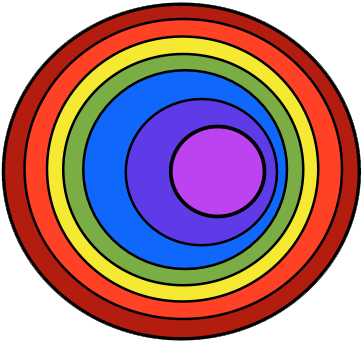 |
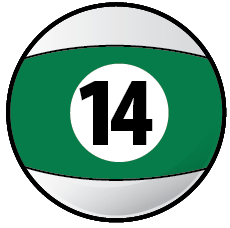 |
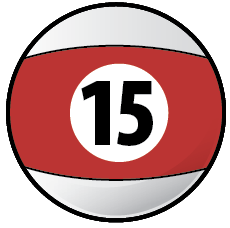 |
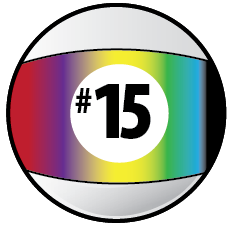 |
References. References for this page's information comes from school, books and the bandstand and made way easier by the folks along the way. |
Find a mentor / e-book / academia Alaska. Always good to have a mentor when learning about things new to us. And with music and its magics, nice to have a friend or two ask questions and collaborate with. Seek and ye shall find. Local high schools, libraries, friends and family, musicians in your home town ... just ask around, someone will know someone who knows someone about music and can help you with your studies in the musical arts. |
|
Always keep in mind that all along life's journey there will be folks to help us and also folks we can help ... for we are not in this endeavor alone :) The now ancient natural truth is that we each are responsible for our own education. Positive answer this always 'to live by' question; 'who is responsible for your education ... ? |
Intensive tutoring. Luckily for musical artists like us, the learning dip of the 'covid years' can vanish quickly with intensive tutoring. For all disciplines; including all the sciences and the 'hands on' trade schools, that with tutoring, learning blossoms to 'catch us up.' In music ? The 'theory' of making musical art is built with just the 12 unique pitches, so easy to master with mentorship. And in 'practice ?' Luckily old school, the foundation that 'all responsibility for self betterment is ours alone.' Which in music, and same for all the arts, means to do what we really love to do ... to make music :) |
 |
"These books, and your capacity to understand them, are just the same in all places. Always bear in mind that your own resolution to succeed, is more important than any other one thing." |
|
Academia references of Alaska. And when you need university level answers to your questions and musings, and especially if you are considering a career in music and looking to continue your formal studies, begin to e-reach out to the Alaska University Music Campus communities and begin a dialogue with some of Alaska's finest resident maestros ! |
|
~ |

